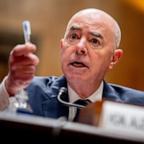Obesity Rates Projected to Soar
Rates of obesity, diabetes expected to climb with catastrophic consequences.
Aug. 25, 2011— -- If waistlines keep expanding at current rates, half of the U.S. population will be obese by 2030, according to a new report.
The current trajectory, according to a two-decade trend of steady weight gain, would see 65 million more obese adults, raising the national total to 164 million. Roughly one-third of the U.S. population is currently obese.
"At the rate we're looking at right now, it's a dire prediction," said Claire Wang, assistant professor of health policy and management at Columbia University's Mailman School of Public Health and lead author of the study that was published in the Lancet. "Something has to be done."
The rise in obesity could lead to 7.8 million more cases of diabetes, 6.8 million cases of heart disease and stroke, and more than half a million extra cancer cases in the U.S. -- all of which would balloon health care costs by $66 billion a year, according to the report.
"It's not only a problem of well-being, it's a financial burden," said Wang. "It's both a public health issue and a health services issue for the states."
But if every obese person decreased his or her body mass index by just 1 percent (a loss of 2 pounds for a 200-pound adult), as many as 2.4 million diabetes cases, 1.7 million cases of heart disease and stroke and 127,000 cancer cases could be prevented.
"We hope we can work together to change the trend," said Wang, adding that solutions have to come from individuals, communities and the government. "We need to change the environment so that we're able to make easy decisions that happen to be the best decisions; the healthiest decisions."
The need for effective, cost-effective solutions is particularly pressing as obese baby boomers move into older age.
"Excess body weight combined with older age is going to lead to an expansion of chronic conditions," said Wang, describing weight's link to such age-related conditions as arthritis. "Our health care system is already struggling with resource constraints."
Obese America Stretching Resources Thin
Dr. Ken Fujioka, director of the Center for Weight Management at the Scripps Clinic in San Diego, said ever-growing waitlists for obesity clinics are already three months long.
"We're having trouble keeping up," said Fujioka, adding that roughly half of patients referred to his clinic are morbidly obese. "On the front lines, it's just frightening."
Obesity treatments, such as bariatric surgery, are effective, but many patients are reluctant to undergo such an invasive procedure. And a dearth of drugs approved to treat obesity leaves few options for extreme weight loss short of strict diets and intense exercise programs.
For now, Fujioka said solutions should focus on prevention. Taxes on unhealthy foods that provide empty calories, like sugary sodas, could help curb consumption and provide revenue for public policy changes, he said.
"Many schools are having to cut down on physical education because of budget constraints," he said. "That is a huge mistake, not being able to get our kids to exercise."
But changes have to come at the family and individual level, too. Buying a bathroom scale can help people stay on top of their weight and monitor small changes. Cutting down on TV time and ramping up regular physical exercise -- even a walk -- can help balance calories consumed and spent. And limiting access to junk food can make it easier to make healthy choices.




